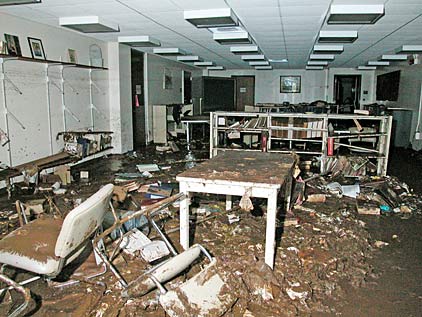
|
Feds to pay $31M
of flood cost
UH wants the state to cover
$25 million more in damage
|
Federal disaster aid will pay about $31 million of the damage and cleanup costs from the Oct. 30 Manoa flood, Gov. Linda Lingle announced yesterday.
|
FLOOD CLEANUP BILL
Here is how the University of Hawaii hopes to pay the estimated $81 million bill for cleanup and restoration work from the Oct. 30 Manoa flood:
» $25 million in insurance payments The $56 million in state and federal funds will be split, with about $28 million in general obligation construction bonds and $28 million in general funds. The bonds will be paid back to investors over several years for construction projects. The general funds come out of the state's operating budget and will be used for such things as the $9 million bill for the contractor hired for immediate cleanup after the flood.
Source: Sam Callejo, UH chief of staff
|
Most of the $31 million will go to the University of Hawaii at Manoa, which suffered about $81 million in damage to 32 buildings from the flooding.
Some of the federal money will go to the city for road repairs and to Noelani Elementary School, which also suffered flood damage, said Ed Teixeira, state Civil Defense vice director.
Insurance is expected to pay for about $25 million of the damage at UH. The Legislature is being asked to fund the remaining $25 million for reconstruction and cleanup.
Sam Callejo, chief of staff at UH, told the House Finance Committee yesterday that the university had already spent $15 million on cleanup costs, taking the money from its fourth-quarter allocation.
He asked lawmakers to pass a bill that would allow UH to spend the insurance money and reimburse itself, and for support in getting the remaining $25 million needed for repairs on campus.
On Tuesday a ceremony was held at UH-Manoa to mark the reopening of Hamilton Library, the building that suffered the most damage from the flood.
The cost estimate to repair just Hamilton Library ranges from about $15 million to $20 million, and the work is expected to take several years.
"Restoration of the university facilities may take up to four to six years, but we're going to move as fast as we can and work with UH to get things back to normalcy and, in some cases, better than they were," Teixeira said.
Acceptance of the federal money will require UH to get additional flood insurance. That means insurance premiums could rise to $650,000 a year from the $350,000 a year the university pays for its current $25 million policy.
In a news release, Lingle expressed her appreciation for the help from FEMA and for the state workers who helped prepare the damage assessments.
The $81 million figure does not include lost revenue from research projects that had to be put on hold or were lost because of the flooding, Callejo said.
UH must negotiate separately with the U.S. Department of Agriculture and the National Institutes of Health for reimbursements for federal research from those agencies, Teixeira said.
www.hawaii.edu
[News] [Business] [Features] [Sports] [Editorial] [Do It Electric!]
[Classified Ads] [Search] [Subscribe] [Info] [Letter to Editor]
[Feedback]

